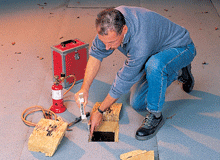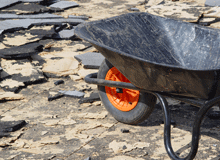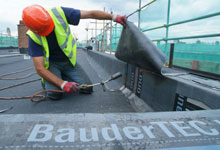Strip Up or Overlay?
Paul Felgate, Technical Development Manager at Bauder Ltd talks through assessing requirements.
Refurbishing an existing flat roof is not always as straightforward as simply telephoning a roofing contractor for a quote. It is generally recommended to have the roof surveyed to discover the scope of works.


There are two options for improving the waterproofing on a current roof; to strip off the failing system or to overlay it. In either case, the first steps are to examine the condition of the deck and supporting structure and the existing waterproofing.
Condition and Nature of the Existing Deck
If this is at all questionable, a structural survey should be commissioned. Generally speaking, decks made from chipboard or strawboard should always be replaced as their lifespan is limited and any water ingress that may have occurred will have reduced their load bearing strength. Metal decks should be checked for signs of corrosion and deflection; and concrete for cracks and movement. Woodwool is now classed as a fragile material and should be treated in accordance with the latest Health and Safety guidelines.
Condition and Nature of the Existing Waterproofing
Investigative core samples should be taken through the existing roof coverings in order to assess the roof build-up and its condition and will determine the course of remedial action. Bauder area technical managers are available to undertake this service free of charge as part of their no obligation survey and report package.
Strip or Overlay the Existing Waterproofing?
The existing roof coverings should always be removed if there is any doubt over their long term integrity or if moisture is present; this may even include any underlying screed. Consideration must be given as to whether stripping the roof will also mean removing the drainage falls, if so, it will be necessary to incorporate a new screed, or more conveniently tapered insulation to re-introduce new falls and maintain adequate drainage of the roof.
If the intention is to overlay the existing roof system, the following basic criteria
should apply: the existing roof system should be generally sound, dry, free from water damage and suitable to take an overlay system; and the overlay materials must be compatible with existing materials. In the case of Bauder bituminous systems this generally means asphalt and in some cases other bituminous membranes. Bauder Liquid systems can be used to overlay almost all types of roof membrane and synthetic single ply can also be used for refurbishment applications in some circumstances.

Other points to consider when proposing to overlay:
- Waterproofing to the upstands and details should generally always be stripped and replaced.
- There will be additional weight imposed on the structure with the overlay system.
- An increased surface level will be imposed by the new system (especially when upgrading insulation) and its effect on adjacent detailing must be considered. Upstand heights should not be compromised and it may be necessary to raise DPC’s, cavity trays, edge kerbs and fascia boards etc.
- Products being overlaid may well have a shorter life expectancy than the new system and ultimately cause premature failure of the overlay system. For this reason it is recommended that existing systems incorporating insulation are stripped rather than overlaid.
- Building Regulations now require insulation to be upgraded in most refurbishment overlay situations.
- In situations where it is not necessary to upgrade insulation, the service life of the roof could be extended by using a dedicated single layer refurbishment system.